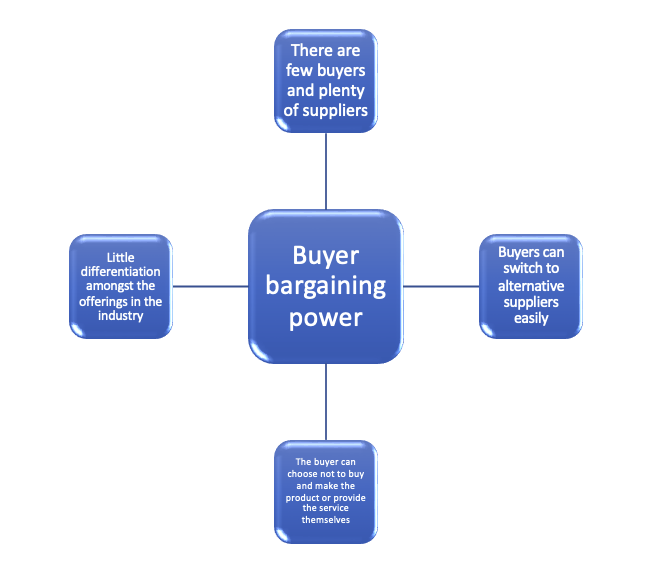Designing for superior business performance
A guide for technology, creative and startup leaders
Choice 2: Where we play - level of buyer bargaining power
In this chapter
Overview of what is the profitability threat from buyer bargaining power
Factors that elevate the threat from buyer bargaining power.
Protecting against buyer bargaining power
Overcoming buying bargaining power
Tools that can help build and sustain your understanding
Introduction
The more bargaining power buyers have, the more power they have in determining price and
terms. When bargaining power of buyers is high,
buyers have greater control over how much value / capital flows into the industry.
Consider as an example, the potato farmer selling potatoes to McDonalds.
There are many potato farmers but only a few buyers of high volume of potatoes.
There is nothing particularly unique or special about one potato farmers potatoes versus
any other, the product is perishable and so there is a need to move the product quickly.
There is usually an abundance of supply and suppliers. These structures, mean the potato
farmers do all the work, but have little bargaining power.
Instead the buyer has the bargaining power.
As an additional example consider the airline industry.
There are an abundant number of airlines all flying similar
routes providing similar service and hence buyers are price sensitive and will
bargain or shop for the lowest prices.
This price sensitivity reduces the total money flowing into the industry,
while the competitiveness reduces the margins available to rivals in the industry.
Bargaining power of buyers is elevated when:
Increased buyer bargaining power puts profitability in the industry segment at risk of being eroded by that buying power.

Buyer bargaining power is elevated when.
There are few buyers and plenty of suppliers.
Buyers can switch to alternative suppliers easily.
The buyer can choose not to buy and make the product or provide the service themselves.
Little differentiation amongst the offerings in the industry.
Review of buyer bargaining power threat factors
Most of these elements are somewhat intuitive, so you can review these factors briefly here before we move on creating and overcome buyer power factors.
Few buyers, plenty of suppliers

Once there are plenty of suppliers of standardized or undifferentiated products, then the product is a commodity and price is the differentiator. Once there are only a few buyers, and plenty of suppliers, (recall this section when you review the rivalry force) then the suppliers will be competing for the few buyers. This gives the buyer the bargaining power.
Contrast this to the alternative, where you have a uniquely valuable offering, that the buyer wants but cannot get anywhere else. Now who has the bargaining power?
Buyer switching costs are low
Switching costs are the costs that a consumer incurs as a result of
changing brands, suppliers, or products.
Switching costs can be monetary in nature,
but also psychological, effort or time-based switching costs.
For example, it does not cost a Facebook or LinkedIn member
money to transfer their social profile
to another platform, but it does take time and effort.
Alternatively, if a business runs its business on a particular technology, then
switching costs could be high.
Alternatively, if the business employees fly between one state office and another then the cost of switching from one airline to another to get a better deal is negligible. In this case the airline traveller has the bargaining power.
Buyer chooses not to buy and make the product or provide the service themselves
In B2B this is also called backward integration. Rather than rely on suppliers, that it
does not have bargaining power over, the business consumer decides to backward integrate
and supply themselves.
Tesla for example, currently rely on high demand lithium-ion batteries for its electric
vehicles. There is an increasing number of demands for these batteries and likely
a lesser expansion in suppliers. Hence, Tesla is increasing becoming at the mercy of these
suppliers, due to its decreased bargaining power. Thus, Elon Musk, has hinted at the possibility that Tesla will need to
establish or become.
its own battery supplier.
Little differentiation amongst the offerings in the industry
A commodity product that can be acquired from multiple suppliers has only price as the differentiator, hence, the buyer is free to shop around for the best price. Assuming any level of rivalry, other businesses will be discounting to obtain buyers and revenue, increasing sales, but decreasing profitability.

Protecting against buyer power
Protecting against buyer power is enhanced by choosing one of the three generic strategies. These are:
-
Low cost provider
Your value proposition already makes your value proposition the lowest cost. Buyers trust your value proposition to provide the lowest or near lowest cost and so they do not bargain for lower, since they cannot get the offering at lower price elsewhere. Example: Walmart
-
Differentiation
Apple computers and computing related devices are not the cheapest. Neither, are Nike sports clothing and shoes. People pay extra because in their minds where value lives in the mind of the customer, these products have unique or superior value.
Differentiation means there is some unique and valuable about your offering, that the buyer might be able to get something similar elsewhere but not the same and therefore not the same satisfaction. In this scenario the offering is not a commodity. There is still an upper limit consumers will pay for the satisfaction, but they do not have as much bargaining power, as for a commodity product.
-
Both low cost and differentiated
Few people bother to shop around for anything cheaper than Amazon or Uber.
Amazon and Uber provide differentiated (superior) products and at lower prices. This means buyers do not shop around to alternatives and therefore do not exert much bargaining power.
Overcoming buyer bargaining power
Overcoming the threats of buyer bargaining power. This may occur in response to:
Advance product / service differentiation
Avoid becoming a commodity
Be the single source of a particular blend of delight.
Establish and maintain cost leadership
Become undisputed or trusted as the lowest cost provider
You will see more about these options during this guide. Particularly, when we progress to developing your unique value proposition.
Continue with supplier power assessment . . .
Assess and adjust the attractiveness of your where to play choice in StrategyCAD™
Try it Learn moreYou can try StrategyCAD™ free for 30 days to build your high performance strategy